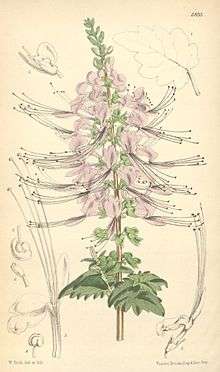Orthosiphon stamineus
| Orthosiphon stamineus | |
|---|---|
 | |
| Scientific classification | |
| Kingdom: | Plantae |
| (unranked): | Angiosperms |
| (unranked): | Eudicots |
| (unranked): | Asterids |
| Order: | Lamiales |
| Family: | Lamiaceae |
| Genus: | Orthosiphon |
| Species: | O. stamineus |
| Binomial name | |
| Orthosiphon stamineus | |
Orthosiphon stamineus is an herb that is widely grown in tropical areas. It is also known as Orthosiphon aristatus. The plant can be identified by its white or purple colored flowers that resembles cat whiskers. It is also commonly referred as "Misai Kucing" which means cat whiskers. The herb is popularly known as Java tea and is used widely in the form of herbal tea in Asia.[1] Java tea was possibly introduced to the West in the early 20th century. The brewing of Java tea is similar to that for other teas. It is soaked in hot boiling water for about three minutes, and honey or milk is then added. It can be easily prepared as garden tea from the dried leaves. There are quite a number of commercial products derived from Misai Kucing. Cultivation areas and post-harvesting method can significantly affect the quality of the herb.
Phytochemicals isolated from the herb include terpenes, flavonoids, caffeic acid derivatives and essential oils.[1] Sinensetin is a polyphenol found in O. stamineus.
Extensive pharmacological investigations on various aqueous and non-aqueous extractives of O. stamineus were carried out to characterize its therapeutic potentials and benefits. Such evidence-based studies revealed that O. stamineus possesses several activities, which are attributed to its phytochemical content. It was found that O. stamineus exhibits diuretic, hypouricemic, renal protective, antioxidant, anti-inflammatory, hepatoprotective, gastroprotective, anti-hypertensive, anti-diabetic, anti-hyperlipidemic, anti-microbial, and anorexic activities.[2][3]
 Orthosiphon stamineus in Malaysia
Orthosiphon stamineus in Malaysia Young leaves
Young leaves Dried leaves
Dried leaves Pollen (electron micrograph)
Pollen (electron micrograph)
References
- 1 2 Chai TT, Wong FC, Abd Manan F, Ooh KF, Mohd Ismail NI (2014). "Orthosiphon aristatus: A review of traditional uses, phytochemical profile, and pharmacological properties". In V.K. Gupta. Traditional and Folk Herbal Medicine: Recent Researches. 2 (1st ed.). New Delhi: Daya Publishing House. pp. 153–187.
- ↑ Ameer, Omar Ziad (2012). "Orthosiphon stamienus: Traditional Uses, Phytochemistry, Pharmacology, and Toxicology: A Review". Journal of Medicinal Food. 15 (8): 1–13. doi:10.1089/jmf.2011.1973.
- ↑ Akowuah, G.A.; Ismail, Z.; Norhayati, I.; Sadikun, A. (2005). "The effects of different extraction solvents of varying polarities on polyphenols of Orthosiphon stamineus and evaluation of the free radical-scavenging activity". Food Chemistry. 93 (2): 311. doi:10.1016/j.foodchem.2004.09.028.
External links
| Wikimedia Commons has media related to Orthosiphon stamineus. |